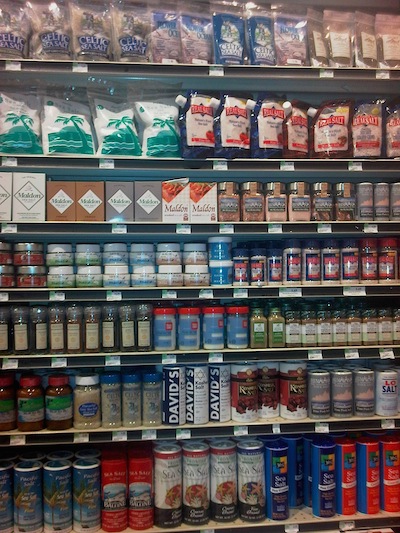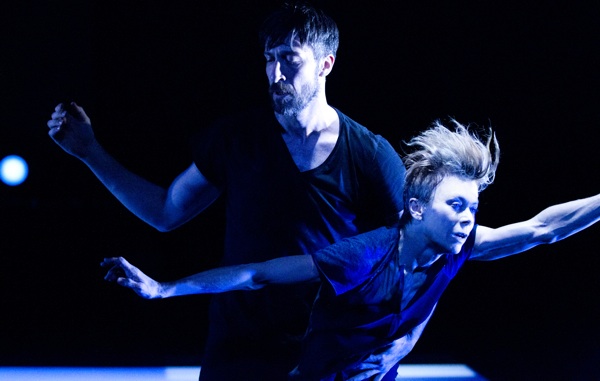Salt Mining
If you go on a field trip to Whole Foods, past the gluten-free section and the house smoked meat counter, you’ll come to an end-cap display with salt, salt from the top shelf to the bottom, forty different kinds. If you want to know what they’re like, you can ask one of the team members, maybe the guy who was restocking farro and red quinoa, and he’ll become a salt sommelier.

He’ll tell you that the Himalayan pink salt has a gentle taste and firm crunch. Maldon evokes the sea and disintegrates like foam. Sel gris is coarse and minerally.
Now ask the salt sommelier, the one who can discern forty kinds of salt, what different kinds of poems are like. Or architecture. Or sculpture. You’ll be met by a blank stare, and a quizzical gaze.
I’m not anti-salt. I think it’s great—if a bit excessive—that we have a vocabulary to talk about what makes one salt different from another. But I find it sad, and telling, that we don’t have a similar ability to discuss the creative culture that surrounds us. Because creative culture nourishes us far more than salt ever can, and the quality of our lives is sculpted by the creative choices we make and share.
That’s the project Cultural Weekly sets for itself.
No Thumbs
“Liked it.” “Hated it.”
“Thumbs up.” “Thumbs down.”
This is the normal discussion of creative culture we find in most of our daily lives, and certainly in the mainstream media.
Creative culture described with two words, and in binary terms, is as boring as it is limited. It’s not particular interesting if someone “likes” or “hates” a poem, a song, a movie, a play, or any other work of art, because there is nothing unique in those words, and they don’t convey meaning. Instead, it is more valuable to discover how the work of art affects us: what echoes it brings to mind; why we are intrigued or repelled; when, in our experience of the work, our emotions twist this way or that.

Choreograper : Louise Lecavalier
Cultural Weekly exists to elevate the conversation, to provide an alternative to mainstream discourse. We offer interviews with cultural creators, and articulate, detailed responses to creative works. We spot origins, beginnings, trends, and sometimes we make them. Our readers and writers are smart and don’t need to hide their intelligence, but we’re not academics, and you don’t need a PhD to read our articles or to write for us.
Because we are not elitist, we are open to everyone. We maintain an open door editorial policy, and we don’t have an aesthetic “party line.” If you can write well, and express your perspective clearly, we’ll run your article: You just need to have an aesthetic, a creative point of view about what is of value. Having an aesthetic is a choice—a choice that’s social, political and creative. What your aesthetic is is a matter of taste, and differs from person to person, and everyone’s aesthetic evolves over time. Cultural Weekly readers and writers have aesthetics. That is the unifying feature that defines us.
But it’s not how we began.
Origin Story
Sometimes where you start does not predict where you’ll wind up.
Lady Gaga started as a go-go dancer. Walter Mosley began as a computer programmer. After dropping out of college, Mark Rothko thought his career would be in the rag trade.
So it has been with Cultural Weekly, in a much more humble way. Where we started isn’t where we are now. Here’s our origin story.
In 2011, after a seven-year stint as president of National Geographic Films, I had contracted with Macmillan Higher Education to co-author a textbook on filmmaking. It was to be a daunting project—large format, massively researched, nearly 500 pages long. Its scale freaked me out, and I had no idea how I’d be able to get that kind of writing done.
Of course, I’d written before… emails, memos, proposals, business plans. None of them had a big page-count, and all were crafted in corporate style, with short sentences, quick summaries and rows of bullet points.
I realized I would have to go to the equivalent of a gym, and tone my writing muscles, get them in shape for the marathon ahead. Why not start a blog? I thought to myself. Just start it, tell your friends you’re going to post a few times a week, and the social pressure will make you do it. You’ll get yourself in the habit of writing, and the big book project won’t seem quite so daunting.
The URL CulturalWeekly.com happened to be available. It sounded legit, and I didn’t want one with my name in it.

As I began posting on the blog (and back then, it really looked like a DIY blog), some of my friends started to read it, and within a few months, one of them asked if he could post a “guest column.” I said, sure. Then another friend asked the same thing. And another. Within six months, Cultural Weekly had transformed, organically, into a place people could say what they wanted to say about our creative culture, and we began a continuous redesign resulting in the digital magazine you’re reading now.
I’m sharing our origin story because it’s important to know that Cultural Weekly isn’t something I just dreamed up and started doing. Cultural Weekly came about because people engaged with it and shaped it into what it is today. Cultural Weekly is an example of user-generated form: our readers have crafted the framework for which the content is written.
Today, Cultural Weekly represents the work of many individuals. Chiwan Choi, a poet and the publisher of Writ Large Press, edits every edition. Sophia Stein interviews the world’s most interesting filmmakers. Poet and photographer Alexis Fancher curates our weekly poetry selections. Former LA Times theatre critic Sylvie Drake reviews theatre, as does David Sheward. Choreographer Sarah Elgart shares her dance videos and the stories of her own experiences. Carol Green’s wry worldview appears in the comic Life After Birth. Environmental designer Maurice Amiel looks at our urban environment and cityscapes. Cultural historian and curator Allon Schoener explores a wide range of arts. Special features editor Tod Hardin seeks out the new and trend-setting, from the artistic renaissance of Detroit to the street art of Beijing and London.
The most important individuals, however, are our thousands of readers, who engage, comment, push, pull, and share these and other stories. Many times, our readers become writers themselves.
Citizen Journalism
Citizen journalism, media discourse by “civilians,” not by so-called professional media reporters, began in the late 1980s and exploded in this decade via social media like Twitter and YouTube.
Cultural Weekly represents the next step in citizen journalism, because we give our writers unlimited freedom to write about their creative passions, at whatever length they choose. The people who write in these virtual pages are not members of the professional media class. Instead, they are people like you and me—readers, writers, poets, thinkers, observers—who care passionately about their subject matter, and want a forum in which to share their views.
In doing so, they form models for articulate discussion of our creative universe, a discussion that is even more nuanced than the taste of salt, and has grander impact on our lives. Everything bears the stamp of an individual perception, from the poetry we run every week, to dance videos, filmmaker interviews, explorations of street art and the designed environment. Everything here is handcrafted… yes, even the mistakes and typos we don’t catch, and the way some of our writers spell theatre with an RE and others with an ER.
We are always looking for more people to write for us; if you’re interested, go here.
If you want to keep supporting our cause, we do love donations.
And if you want to take a field trip, we’ll recommend the Beatrice Wood Center for the Arts in Ojai. Wood was the world-renowned potter and sculptor who famously said, “My life is full of mistakes; they’re like pebbles that make a good road.” You’ll find inspiration in her house and studio, the trees that seem to speak, and the presence of more kinds of sculpture than there are salts at Whole Foods. In fact, I took the photo surrouunding this article in her studio, mesmerized by the number of tools she used to craft her work.
